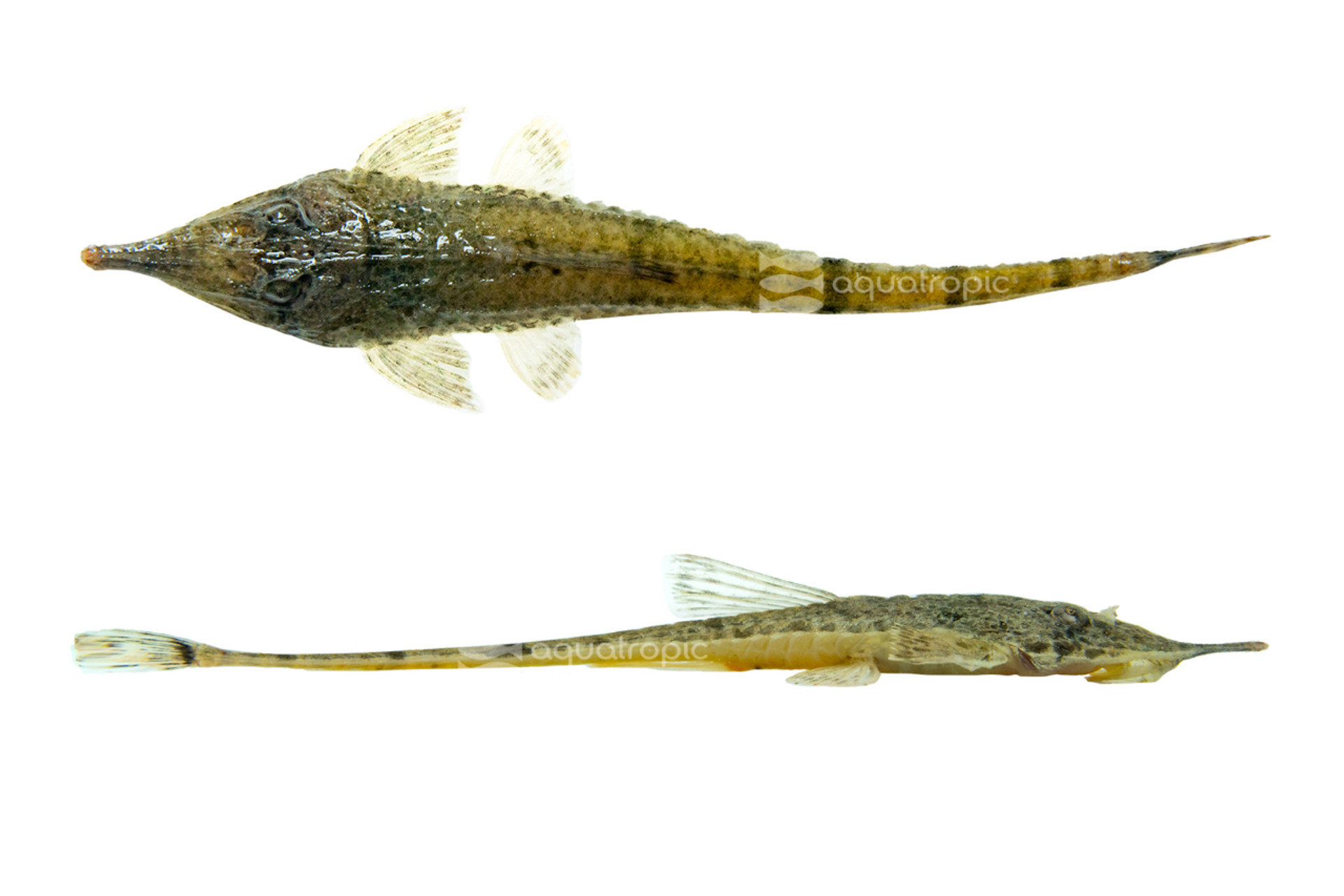Someday, You'll Be A Real Catfish

There is no lie in saying that the Pinocchio Catfish (also Pinocchio Whiptail Catfish) are some of the coolest cats we see around here. They get this common name from a long slender mouth (nose) and that bit's similarity to the puppet of the same name. It occasionally gets called the Knobnose (=/- Whiptail) Catfish. Among the scientifically minded, it bears the tongue twisting moniker, Hemiodontichthys acipenserinus, which easily qualifies it for our list of nearly impossible to say binomial nomenclatures!
These little cats come from south America and are common in a few different river systems across Brazil, Boliva, Peru and Guyana (maybe more). The habitats the Pinocchio Catfish come from are rivers that are generally stable, clean, moderately soft and slightly acidic. Many individuals of this species you'll find are wild caught, and so the water chemistry and quality parameters are more important than for many other, more commonly seen and aquacultured south American catfish. While easy to keep, and pretty hardy, they can be susceptible to swings in water quality, temperature or chemistry; stability is important! Keep temperatures in the mid to high 70s, pH between 6.0 and 7.0 and the hardness under 10 degrees, especially for wild caught specimens.
Pinocchio Cats need good oxygenation and flow and will do best in a display that features a soft sand, so flow must be balanced to deliver enough oxygen, but also not overly disturb the substrate. The fish will gently root through this sand, looking for food, and will sometimes partially bury themselves to hide when resting; this is fascinating behavior to get to watch in your home aquarium. Oxygenation is key with this species, so you'll want to choose very active specimens from your local fish store and transport them without undue delay. To help with oxygenation, you can also add supplemental oxygen with air stones etc. They only get about five inches long, so they don't need much space. You could keep one in a 40-gallon tank. They are fine in planted displays but will like some open sand to work with. Smooth stones and driftwood without sharp edges or points will work well for aquascaping and cover. Some floating plants will help keep the aquarium lighting subdued and diffuse. They'll also love some leaf litter if this is your chosen aesthetic.
Even wild specimens of Pinocchio Catfish are easy to feed. Their wild diet is almost completely made up of small invertebrates that they find in the sand. In your aquarium, they'll relish Gamma Bloodworms, Tubifex, White Mosquito Larvae and all of the Brine and Brine Plus products. They will also happily take down small live foods like tubifex, chopped earthworm, small red worms and even meal or wax worms. They can be trained to take a good pellet like Nutramar Freshwater Complete, but they are pretty slow eaters and will have limited opportunities. We like to feed them in low-light situations, like just before the lights come up and just after the lights go down to help them get more food. Be wary of overfeeding them because they don't like nitrogen spikes.
These are very peaceful fish, even with other bottom dwellers and other Pinocchio Cats. They are easily kept in small groups, which will allow the home aquarist the opportunity to get a pair of them for breeding purposes. They have been bred and fry successfully reared in home aquariums. If you're interested in trying this yourself, increase your water changes in both volume and frequency and make sure your fish are very well fed. When ready to spawn, the males' noses will actually get bigger (still no lies told here). While they spawn at night, you'll know when it's happened because you'll notice the male carrying eggs around in their lower jaw / lip. It takes roughly two weeks for the eggs to hatch (faster in warmer water, slower in cooler water). After hatching the male will defend these fry for a few days to about a week and at that point, the babies will be able to take fairly large food, like microworms and brine nauplii. They fry are a very edible size though, so if you want to raise them, the carrying male should probably be removed to his own tank before the eggs hatch, or conversely, all the other fish removed from the main display. In regard to other tank mates, these cats will get along well with small fish like Tetras and Rasboras, some larger fish like Angels, as well as peaceful bottom dwellers like Apistogramma Cichlids, Corys and Otos etc.
All in all, the Pinocchio is a very unique looking and peaceful cat for community aquariums. They stay small making them appropriate for a huge number of aquarium sizes and as an extra added bonus, they are fascinating to watch! If this sounds like a good fit for your current display, or maybe an element of your next aquarium, head to your LFS and ask them for a small group of Hemiodontichthys acipenserinus from Aquatropic today!